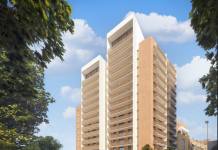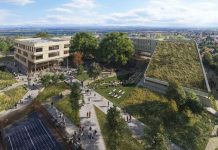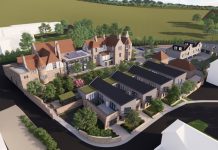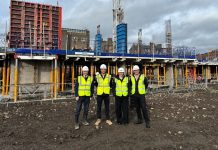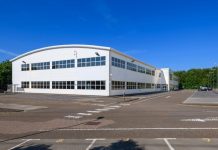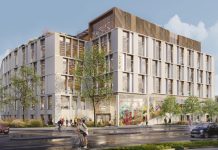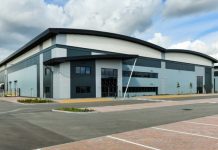Investment in the East Midlands’ commercial real estate sector smashed to a record-breaking level of £2.29 billion in 2021, according to the region’s annual property review by Innes England.
The figure was almost double that of the previous year and 71% above the five-year average with the industrial market leading the way, said Ben Robinson, head of Innes England’s investment consultancy.
The impressive figures were revealed in the leading agency’s 15th Market Insite report – presented virtually again this year – which monitors trends in the regional property market, focusing on Leicester, Derby and Nottingham.
“The industrial market accounted for more than three-quarters of all transactions, a strong increase on the previous year’s 50% market share and further reinforcing the region’s ‘golden triangle’ reputation,” said Ben.
But he warned that supply of stock has struggled to keep pace with the strong post-lockdown rebound in investor demand.
Across the East Midlands, the report highlighted:
- The region’s distribution market continues to thrive. Logistic deals included the sale of Amazon’s one million sq ft warehouse at Bardon, Leics, to Savills IM for £161m
- Large sites being developed include East Midlands Gateway near Junction 24, the new £150m global hub for Jaguar Land Rover near Ashby and the continuing expansion of Magna Park near Lutterworth
- ‘Surprising’ results in the office take-up sector across the East Midlands, including a 122% jump in Leicester
- Retail footfall in all three cities improved – with Nottingham at 83%, Leicester 93% and Derby at 102% of pre-pandemic levels
- Nottingham and Derby experienced increased levels of industrial take-up
- Commercial real estate investment in Leicestershire rose to £629m in 2021 – almost double the previous year
- Investment in Derbyshire more than tripled, reaching heights of £380.5m
- Competition for industrial sites in Nottingham soared
“Overall, 2021 was dominated by a large number of deals in the ‘sheds and beds’ space, with office and retail lagging behind,” added Ben.
Peter Doleman, Innes England director of agency and development, told the Market Insite webinar that Nottingham and Derby experienced increased levels of industrial take-up.
Greater Nottingham increased from 708,000 to 950,000 sq ft, thanks to the availability of new speculative stock – increasing Grade A take-up fourfold over the last 12 months.
Derby increased from 591,000 to 891,000, to a great extent due to the single letting to JD Sports of 515,000 sq ft on the Derby Commercial Park.
“Leicester saw a small drop of 5%, from a little over 3 million sq ft at the end of 2020 to 2.8 million sq ft last year, still a substantial overall level but reflective of the availability of larger buildings at Magna Park, for example,” said Peter.
Supply is now the key factor in order to keep the industrial market moving, says the report. Greater Nottingham has a ‘chronic’ lack of supply as levels almost halved at year end to 434,000 sq ft, with 50% of that under offer.
Industrial availability in Derby dropped to just over 200,000 sq ft from 364,000 sq ft in 2020, with no buildings over 30,000 sq ft ready to occupy being on the market. However that need has been addressed with St Modwen on site having committed £46m to deliver 300,000 sq ft in late summer this year.
Leicestershire’s supply remains broadly the same as 2020 at 3.2m sq ft, again reflecting the availability of some larger buildings but will see the creation of a number of new speculative schemes that will bring much-needed stock to the market.
Second-hand stock remains painfully thin on the ground across the region and commands premium prices when available, said Peter.
“We have seen values generally rise over the last two years, due not only to a lack of supply and the resultant competition for buildings, but also Brexit and the pandemic that have caused supply chain issues and inflation that has raised the cost of development,” he explained.
“What is interesting is a general expectation from occupiers that rents and capital values would rise for new buildings, and a willingness to pay these levels.”
The demand in the big box distribution sector, fuelled by the surge in online retail sales, has seen a number of large sites being developed, Peter added.
In office take-up, Leicester saw a jump from 193,000 sq ft to 429,000 sq ft, up 122%; Nottingham’s increased by nearly 20%, from 295,000 sq ft to 352,000 sq ft, and Derby recorded a 43% rise from 156,000 sq ft to 224,000 sq ft.
The report says the office market is at an interesting stage, with the start of a possible strategic change in the need for offices and how that will affect demand and supply regionally.
Despite the distribution sector’s ‘stellar’ growth, all three cities had improved footfall data, with Derby at 102% of pre-pandemic levels, said Innes England managing director Matt Hannah.
The past six months have seen strong sales growth from pre-pandemic levels for a number of retailers but the market has been facing structural challenges from the internet, making it difficult to assess where headline rents sit, he said.
“City centres and secondary shopping centres have been hit the hardest. Regionally, we have seen national retailers open in all our cities and with some repurposing and rebasing of rents, more local operators have secured sites in prominent trading positions.”
The destination retail and retail warehousing sector is healthy, with investors looking to secure assets, while drive-thru restaurants and other roadside businesses such as car supermarkets and home retailers – fared well during the pandemic, said Matt.
“Drive-thru units have been tested by a wider range of operators and this means the best locations are hard fought over,” he said. “Greggs are increasing their portfolio of drive-thru sites, with one of their earliest commitments being Southwell Road West in Mansfield.”
There will be a new dynamic in the value of roadside sites as the EV charging network continues to grow. Online car retailers such as Cazoo, Cinch and Carzam are also seeking networks of dealership sites, although traditional dealers are currently in great shape.
The food sector, local shopping and destination retailing will continue to perform well. But Matt warned that while there was increasing confidence that social restrictions will no longer be an issue in 2022, it could be ‘the year of the squeeze’ as inflation reaches 5% and anticipated sales growth is at 3.3%.
However, he pointed to success stories in all three cities, such as Frasers Group taking 127,000 sq ft in the Derbion Centre. The £168m extension to Leicester’s Fosse Park was opened and the city’s railway station is having a £17m facelift.
And he hailed the planned transformation of Nottingham’s half-demolished Broadmarsh shopping centre. Matt added: “This is a generational opportunity to develop 20 acres to suit the demands of a modern city. Lots of city centres across the globe would love to have such a significant opportunity to bring forward relevant and exciting new space.”

